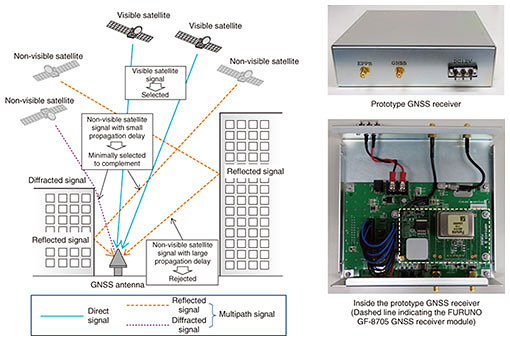 |
|||
|
|
|||
|
Short Reports Vol. 17, No. 4, pp. 45–47, Apr. 2019. https://doi.org/10.53829/ntr201904sr1 GPS Time Synchronization with World-class Accuracy Using Selected Satellites—Multipath-tolerant GNSS Receiver Dramatically Increases Accuracy in Severe Environments1. IntroductionNTT and FURUNO ELECTRIC CO., LTD. (hereafter, FURUNO) have developed a receiver for the Global Positioning System (GPS) and other global navigation satellite systems (GNSS) that dramatically improves time synchronization accuracy in areas with severe reception conditions such as among buildings and in mountainous areas. The integration of a new satellite signal selection algorithm developed by NTT into a time-synchronization GNSS receiver from FURUNO, in addition to signals from satellites in line-of-sight locations, has made it possible to use multipath signals (reflected or diffracted from buildings and other structures), which previously inhibited the accuracy of time synchronization. In a real multipath reception test environment, the time error was reduced to approximately one-fifth that of earlier values. This is a remarkable result in that it promises to enable time synchronization accuracy close to that obtained in open-sky reception environments with no obstructions, even in environments previously considered poor and unsuitable for accurate time synchronization, such as among buildings or in mountainous areas. FURUNO plans to begin sales of their new GF-88 series time-synchronization GNSS receivers incorporating this new algorithm in April of 2019 and to deploy it widely in fields such as 4G/5G (fourth-generation/fifth-generation) mobile base stations, financial trading, power grids, and datacenters. 2. BackgroundAccurate time synchronization with Coordinated Universal Time (UTC),* using a GNSS such as GPS, is used in a wide range of fields for synchronizing mobile base stations, financial trading, earthquake measurements and other purposes. Particularly in recent years, mobile base stations based on TD-LTE (time division Long Term Evolution) and other TDD (time division duplex) methods are spreading globally and require transmitted signals to be synchronized accurately, down to the microsecond, to avoid interference of signals between cells. However, in non-ideal reception environments such as in areas with many buildings or mountains where structures surround the antennas, the open area where signals from navigation satellites can be received directly is limited, and reception of multipath signals reflected from or diffracted by surrounding structures can significantly degrade the accuracy of time synchronization. Measures to improve time synchronization accuracy have been studied in the past, including placing antennas in locations where they can receive signals directly from greater numbers of visible satellites, and also filtering based on the elevation of the signal direction or a signal strength threshold to exclude signals from non-line-of-sight satellites that cannot be seen directly from the receiver location. Even so, these earlier methods were not always able to ensure adequate accuracy, and they also had issues with reliability. NTT has developed a new GNSS receiver algorithm for selecting suitable navigation satellite signals and conducted measurements to verify the effectiveness of this algorithm.
3. Research description and resultsTo compute the four parameters for position and time from navigation satellite signals, signals from at least four satellites must be received, but it is not always possible to receive four or more signals from visible satellites in so-called urban canyon environments obstructed by surrounding buildings. In this study, we have conceived a new satellite selection algorithm in which satellite signals suitable for improving the time accuracy are selected in an iterative selection process based on the estimated reception location and the signal arrival times. As shown in Fig. 1, this algorithm first selects the signals from visible navigation satellites, and if there are fewer than four, it also selects the minimal number of signals with the smallest propagation delay from non-visible satellites. Thus, in poor reception environments, accuracy is improved by aggressively pruning unsuitable satellite signals. This could be called a select few satellite selection method. We developed a prototype by incorporating this algorithm into the GF-87 time-synchronization GNSS receiver from FURUNO and evaluated its performance in a test environment with multipath reception. We were able to demonstrate accurate time synchronization with a time error of approximately one-fifth that of earlier devices (Fig. 2).
Since this method is able to select the best satellite signals regardless of the number of visible satellites in the environment, antennas can be installed with less attention to the location, and significant increases in accuracy of time synchronization can be expected in a wider range of reception environments. For InquiriesPublic Relations Office, Planning Department, NTT Information Network Laboratory Group |
|||










